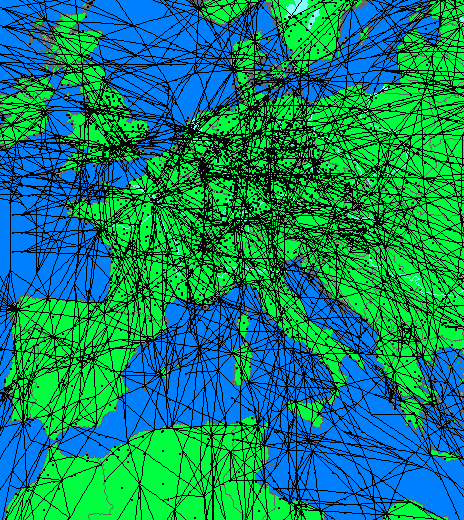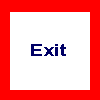
Airline Operations in Europe

Before an aircraft is allowed to take off and fly in Controlled Airspace in Europe the aircraft must have radio equipment such as transponders VHF radios navigational aids. The pilots are not allowed into Controlled Airspace unless they have a type rating on their aircraft and hold a current medical certificate and a Radio Operators Licence and a Full Instrument Rating. These requirements therefore keep light aircraft pilots out of controlled airspace or they have to fly underneath it or at the side.
In addition a flight plan must be submitted to the Air Traffic Control Network with the proposed route height and speed callsign and aircraft details with departure and arrival times etc at least one hour before flight The aircraft must have been cleared to enter into controlled airspace by ATC.
Around airports there are Control Zones and Aerodrome Traffic Zones that pilots have to get clearance from Air Traffic Control before entering or transiting . On Controlled Airports no vehicle or aircraft is allowed to move in the controlled apron area without Air Traffic Control permission. Aircraft cannot take off and land without ATC permission.
Airlines that fly these routes and services on a regular basis have a facility to submit repeat flight plans Each country with assistance of Euro Control bring out preferred routes for the aircraft to fly. This is contained in the Route Availability Document (RAD)
THE AIRAC PROCEDURE IS ISSUED EACH MONTH WHERE ALL THESE NEW WAYPOINTS AND ROUTE CHANGES ARE MADE. YOU CAN UPDATE YOUR FLIGHT SIM AIRCRAFT DATABASES FOR A SMALL FEE. ALSO FLIGHTPLANNERS LIKE FS NAVIGATOR 4 OR AEROSOFT FLIGHT SIM COMMANDER can be updated.
Airways links points on these routes some of these airways are one way some are two way. Aircraft do not route out and back the whole of the same route. For example traffic flying from the UK to Tunisia would route out to the West of London and Paris and back via the East Side. These routes are fine tuned each month to make delay less of a problem. The Military train during the week and some routes are not available but weekends the routes can go over inactive military areas. Airways are numbered with a letter and a number. At major airports Standard Instrument Departures (SIDS) are flown away from airports until joining the airway and Standard Arrival Route STARSs are flown at the approaching the destination Initial Approach Fix or holding pattern. to airports. At less busy airports the aircraft may leave Controlled Airspace and fly on a radar advisory service between the airport and controlled airspace. The map above shows only the upper air routes in Europe. Below them is the lower structure. Had I included them in the map of Europe would have disappeared completely. This gives you an idea of complexity.
Years ago many aircraft got delayed on route and circled to land burning more fuel at destinations. What happens now is all flights plans go through a flow control unit in Brussels at Eurocontrol. each Air Traffic Control Centre tell EuroControl how many aircraft per hour they can handle. With Traffic in all directions in Europe this can overload a centre. Eurocontrol feed all the details into their computer and if the problem is too much traffic they issue pilots with a time for take off. This time is known as a slot time. It can mean a rerouting also. This is so the Air Traffic Controllers avoid being overworked with safety as first consideration.
The aircraft take may take off up t 5 minutes early or up to ten minutes later from the given slot time or the clearance will be cancelled . A new slot time will then have to be renegotiated. This could be a big delay. it is important therefore the aircraft is ready to depart on time and enough time allowed to get to the runway. London Heathrow advise 30 mins taxi time from Gate to Departure runway. Now you know why you have to check in two hours early for a flight or the captain will not let you on if you turn up late. They must not miss the slot. Its crucial for the captain to get the taxi time right to the departure runway and when to push back.
Eurocontrol which handles upper traffic over Belguim Holland and parts of Germany reached a new record Peak Traffic Day on Friday, the 13 June 2008. Traffic Demand was recorded at 33 833 flights. This gives you a idea of why these flow control procedures are required. A closer look at the pilots side of the job will be contained in other items in the website. At least now you understand what the controllers have to do.in liason with the pilots and airlines. Controllers have to keep aircraft seperated between 3 and 5 miles at the same height maintain an orderly stream of aircraft or apply 1000 ft seperation vertically.
Using add on aircraft like the Level D 767 with a decent flight planner program that uses the Airacs that you can update from Navigraph monthly or quarterly for a small fee and using a program called radar contact for Air Traffic Control is about as real as it can get. its well worth doing. All this can be simulated.
Below are some excellent links for you do have a look at the Eurocontrol short video presentations this will give you a behind the scenes look in the fly series. Last year the United Kingdom National Air traffic Service NATS handled some 2.6 million flights.
| Eurocontrol fly series short Videos | |
| Eurocontrol Flow Management | |
| UK NATS Air Traffic Control Website | |
| NATS Useful documents charts etc for UK | |
 |
To Flight School |